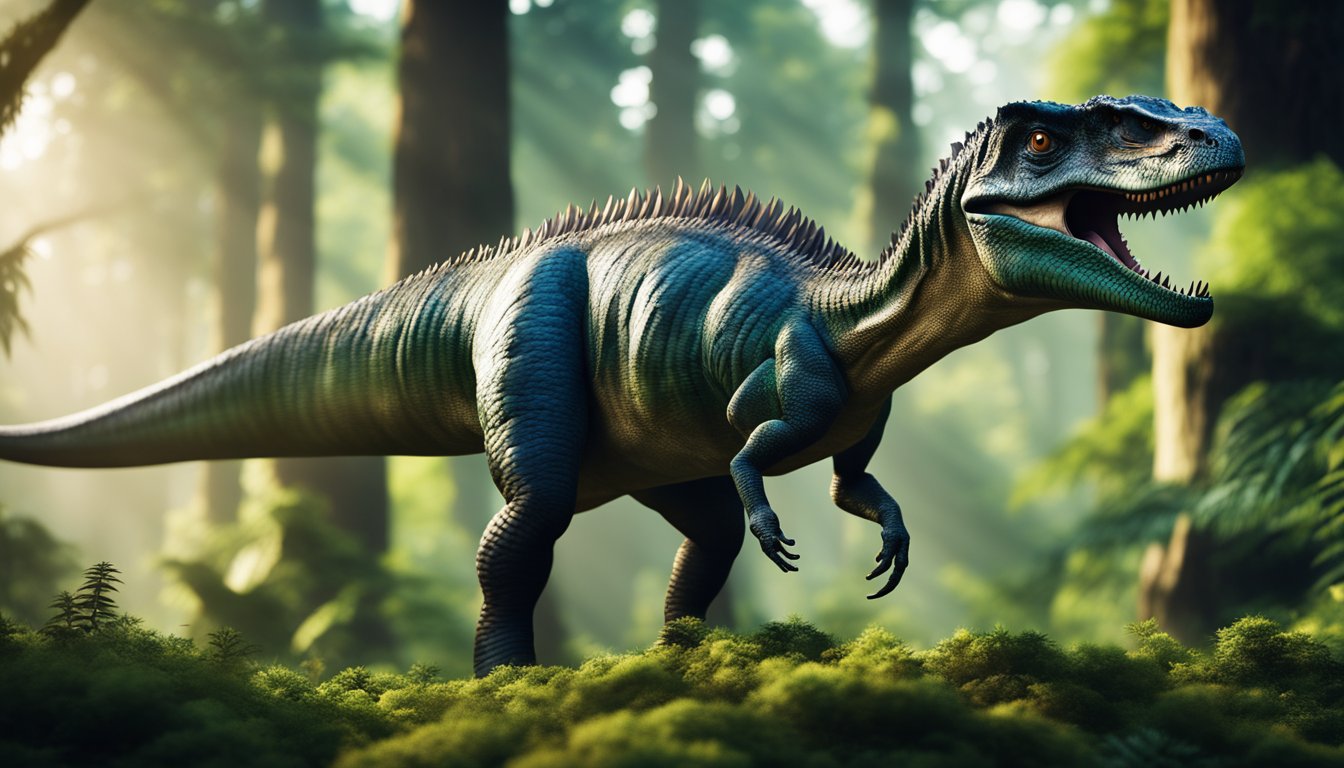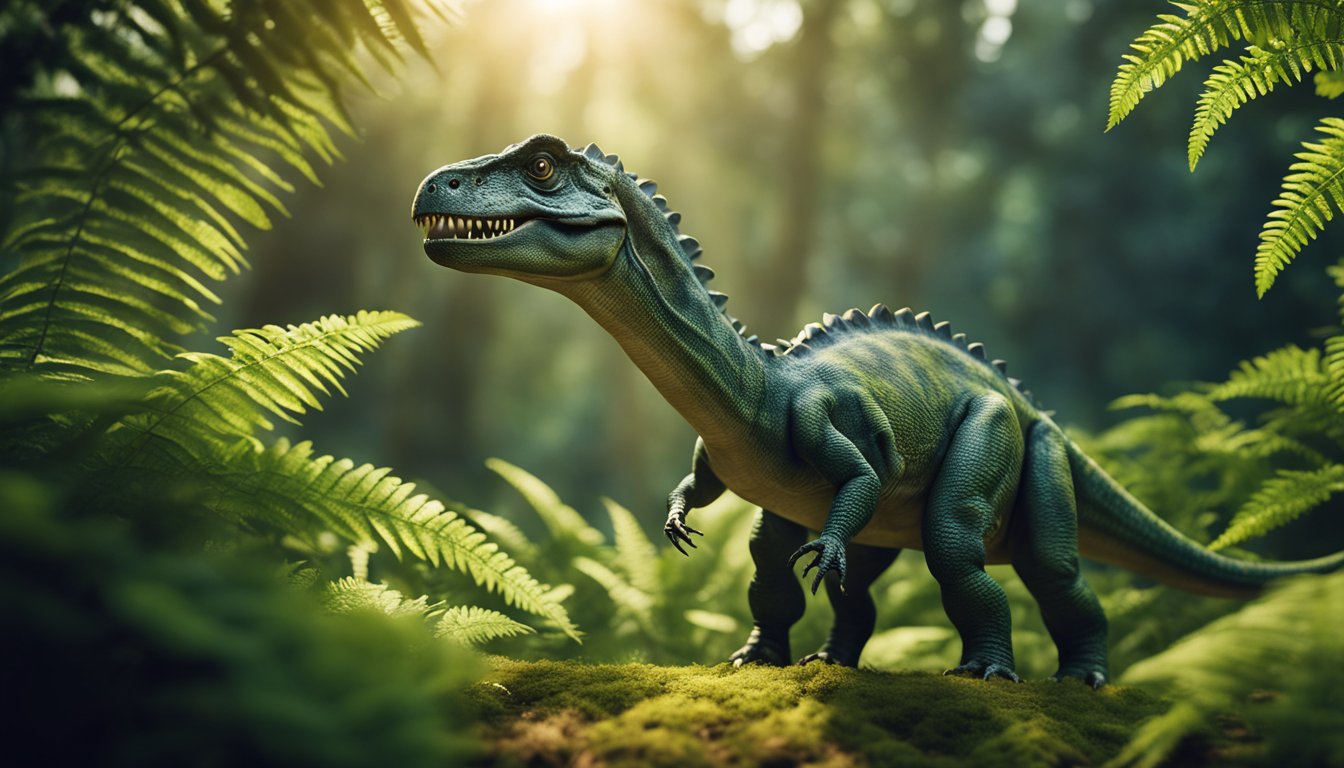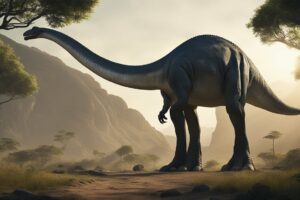Discover the Amazing Story of a Dinosaur that Adapted to Extreme Conditions!
Leaellynasaura, a small dinosaur that lived during the Early Cretaceous period, is a fascinating creature that has captured the imagination of paleontologists and dinosaur enthusiasts alike.
This herbivorous dinosaur was discovered in Australia and is named after the daughter of the scientist who found its fossils, making it a unique and personal discovery.

One of the most interesting things about Leaellynasaura is that it lived in what is now known as Australia, which was located within the Antarctic Circle during the Cretaceous period.
This meant that the dinosaur had to adapt to long, dark winters, which would have made it difficult to find food.
To overcome this challenge, Leaellynasaura had large eyes that helped it see in the dark, allowing it to find food even during the winter months.
It is also believed that this dinosaur had a relatively large brain, which would have helped it process information and make decisions in its environment.
Leaellynasaura is a unique dinosaur that has captured the attention of scientists and the public alike.
Its ability to survive in a harsh environment and adapt to its surroundings is a testament to the resilience of these ancient creatures.
Through the study of this dinosaur, we can learn more about the natural world and the ways in which animals have evolved to survive in different environments.
Discovering Leaellynasaura

Leaellynasaura, the small ornithopod dinosaur, has a fascinating story that begins with the discovery of its fossils in Dinosaur Cove, Victoria.
This section will explore the rich family legacy that led to the unearthing of Leaellynasaura and the significance of the fossils found in Dinosaur Cove.
The Rich Family Legacy
Tom Rich and Patricia Vickers-Rich were paleontologists from Melbourne who devoted their lives to studying the ancient creatures that roamed the earth millions of years ago.
Their passion for paleontology led them to explore the remote Dinosaur Cove in Victoria, where they discovered a treasure trove of dinosaur fossils, including the remains of Leaellynasaura.
The Rich family’s contribution to the field of paleontology is immeasurable, and their work has helped us better understand the evolution of life on earth.
Tom and Patricia’s daughter, Simone Rich, has also followed in her parents’ footsteps and is a paleontologist herself.
Unearthing the Past in Dinosaur Cove
Dinosaur Cove is a unique location that has yielded some of the most significant dinosaur discoveries in Australia.
The fossils found in Dinosaur Cove have allowed paleontologists to piece together the puzzle of Australia’s ancient past and understand the diversity of life that existed millions of years ago.
Leaellynasaura was discovered in 1989 in Dinosaur Cove, and its fossils have since provided valuable insights into the behavior and physiology of this small dinosaur.
The fossils of Leaellynasaura were found in one of the three tunnels that the research dig crews excavated with explosives to follow fossil-rich deposits into the sandstone cliffs.
The fossils were then carefully extracted and taken to the Museum of Victoria for further study.
The discovery of Leaellynasaura has shed light on the diversity of dinosaurs that existed during the Early Cretaceous period in Australia.
Its fossils have helped paleontologists understand the unique adaptations of these ancient creatures and how they survived in a world that was vastly different from our own.
In conclusion, the discovery of Leaellynasaura in Dinosaur Cove is a testament to the hard work and dedication of paleontologists like Tom and Patricia Rich, who have devoted their lives to understanding the ancient creatures that roamed the earth millions of years ago.
The fossils found in Dinosaur Cove continue to provide valuable insights into the evolution of life on earth and inspire future generations of paleontologists to continue the search for answers about our planet’s past.
Leaellynasaura’s World
Leaellynasaura was a polar dinosaur that lived in the southern polar region of Victoria, Australia, around 110 million years ago, during the Early Cretaceous period.
This small ornithopod was about the size of a turkey, measuring only 2 meters long, and weighed around 20 kilograms.
It was named after the daughter of its discoverers, Leaellyn Rich and her father Tom Rich, who found its fossils in 1989.
Life in the Polar Darkness
Leaellynasaura lived in a harsh environment, where the winters were long and dark, and the summers were short and cold.
During the winter, the sun would not have risen above the horizon for weeks on end, leaving the land in almost complete darkness.
The snow would have covered everything, making it difficult for Leaellynasaura to find food.
To survive these extreme conditions, Leaellynasaura had to adapt to life in the polar darkness.
One way it did this was by hibernating during the winter months, like some animals do today.
This allowed it to conserve energy and survive the long, cold nights.
Adapting to Extreme Seasons
Another way Leaellynasaura adapted to life in the polar darkness was by evolving large eyes, which helped it see in low-light conditions.
Its optic lobes were also larger than those of other small ornithopods found elsewhere, indicating that it was more active during the winter months when the sun was low in the sky.
Leaellynasaura also had other adaptations that helped it survive in its extreme environment.
For example, it had a long tail that helped it balance on slippery surfaces, and its legs were longer than those of other small ornithopods, which helped it move through the snow.
Despite the challenges of living in the polar darkness, Leaellynasaura was able to thrive in its environment for millions of years.
Its fossils have provided scientists with valuable insights into the adaptations that allowed it to survive in one of the harshest environments on Earth.
Anatomy and Lifestyle

Small but Mighty Herbivore
Leaellynasaura was a small but mighty herbivorous dinosaur that lived during the Early Cretaceous period in what is now Victoria, Australia.
As an ornithopod, it belonged to the group of dinosaurs that walked on two legs and had a bird-like hip structure.
Leaellynasaura was a hypsilophodontid, a type of ornithischian dinosaur known for their small size and rapid growth.
Despite its small size, Leaellynasaura had a large brain and large eyes, indicating that it was an intelligent and visually acute dinosaur.
Its skull had large eye sockets, suggesting that it was adapted to low-light conditions.
This adaptation was essential for survival in the southern polar region where it lived.
During winter, the sun would not have risen above the horizon for weeks on end, leaving the region in complete darkness.
Survival Strategies
Leaellynasaura had several survival strategies that enabled it to thrive in the harsh Antarctic conditions.
It lived in burrows, which provided protection from the cold and predators.
The burrows were also a place where Leaellynasaura could conserve energy during the long winter months.
Being a herbivore, Leaellynasaura fed on plants, which were abundant in the region.
Its teeth were adapted for grinding tough plant material, and it had a long tail that helped it maintain balance while feeding.
In fact, the dinosaur’s tail contained over 70 vertebrae and made up a stunning 75 percent of its total body length!
Leaellynasaura fossils have provided scientists with valuable insights into the life of this remarkable dinosaur.
By studying its bones and teeth, scientists have been able to reconstruct its growth and development, as well as its diet and lifestyle.
Fun Fact: Leaellynasaura was named after the daughter of its discoverers, Patricia and Tom Rich.
Frequently Asked Questions

How did Leaellynasaura adapt to its environment?
Leaellynasaura lived in a cold and dark environment during the Early Cretaceous period in what is now Victoria, Australia.
To survive in such harsh conditions, it had to adapt in several ways.
For instance, its eyes were adapted to see in low light, and its long tail helped it maintain balance on slippery surfaces.
It also had a high metabolism, which allowed it to generate enough body heat to keep warm.
What can we learn from the Leaellynasaura’s fossils?
Leaellynasaura’s fossils have provided scientists with a wealth of information about the dinosaur’s physical characteristics, behavior, and habitat.
For instance, by studying the dinosaur’s teeth, scientists have been able to determine that it was a herbivore that ate tough, fibrous plants.
Additionally, the dinosaur’s fossils have helped scientists understand how it coped with the lack of sunlight in its environment.
How big was the Leaellynasaura compared to modern animals?
Leaellynasaura was a small dinosaur, measuring only about 1 meter (3.3 feet) in length and weighing around 20 kilograms (44 pounds).
To put that into perspective, it was roughly the size of a large dog, such as a German Shepherd.
What type of habitat did Leaellynasaura live in?
Leaellynasaura lived in a forested environment that was located within the Antarctic Circle during the Early Cretaceous period.
The environment was cold and dark for several months of the year, and the dinosaur had to adapt to these conditions to survive.
How do scientists believe Leaellynasaura coped with the lack of sunlight?
Scientists believe that Leaellynasaura coped with the lack of sunlight in its environment by being active during the twilight hours of the day when there was some light available.
The dinosaur’s large eyes were also adapted to see in low light, which would have helped it navigate through the forest.
What are the distinctive features of the Leaellynasaura’s skull?
One of the most distinctive features of the Leaellynasaura’s skull is its large eye sockets, which suggest that it had excellent vision.
It also had a short, deep snout, which was adapted for eating tough, fibrous plants.
Additionally, the dinosaur had a small braincase, which suggests that it had a relatively small brain compared to other dinosaurs of its size.





